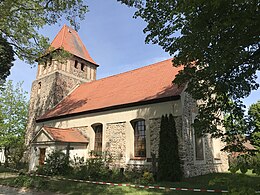Krugau village church
The evangelical village church Krugau is a field stone church from the 15th century in Krugau , a district of the municipality Märkische Heide in the district of Dahme-Spreewald in the state of Brandenburg . The church belongs to the parish of Lower Lausitz the Evangelical Church Berlin-Brandenburg-Silesian Oberlausitz .
location
Landstrasse 443 runs as Krugauer Dorfstrasse coming from the north in a southerly direction through the village. In the historic center of the village, it also branches off as Krugauer Dorfstraße in an easterly direction. The church is located northeast of this intersection on a property with a church cemetery , which is enclosed with a fence .
history
The sacred building was built in the 15th century. In 1821 the nave windows were widened in the shape of a basket arch; the tower received a hipped roof . In 1837 a vestibule was added to the south long wall of the ship. A restoration took place between 1989 and 1992.
Building description
The structure was essentially made of small field stones that were not hewn or layered. The choir is straight and has not moved in. On the east wall are two large arched windows that were built into rectangular, plastered bottles . In the center is a clogged, narrow arched window reaching into the gable . To the south the remains of a window that was also clogged are clearly visible. Together with slight signs of construction on the northern side, a group of three windows may have originally been located at the choir. In the unplastered gable there is a narrow, high rectangular opening in the middle.
The nave has a rectangular floor plan. On its north side are three large, also arched windows. Their fins merge into a plastered band that creates a transition to the eaves . There are two windows of the same type on the south side. In the middle is a vestibule consisting of a rectangular extension that can be entered from the south through a high rectangular gate. The ship and annex have a simple gable roof .
The square west tower was made of larger-format, but also uncut field stones and is slightly drawn in opposite the ship. It can be entered from the west through a small, pressed segment arched portal. The garment was made of reddish brick. There are still no openings on the lower floor . On the west side there is a small opening on the middle floor. Above this, as on the north and south sides, is a pressed segment arch-shaped panel with a small opening. Above is the bell floor. It was built from reddish bricks and richly decorated. On the outside there are masonry panels, between each two smaller acoustic arcades , each with an additional panel below. The tower ends with a transverse hipped roof with a cross.
A memorial to the west of the building commemorates those who died in the world wars.
Furnishing
The pulpit altar dates from the beginning of the 18th century. Its aedicule shape was renewed in 1969 and later revised. In the predella , between two pillars, the Lord's Supper can be seen in an oval painting. This is followed by the three-sided pulpit between gilded vine-leaf columns. Angels with trumpets are attached to the side, above a sound cover with a bow-shaped crown , which shows Christ as risen.
The horseshoe gallery dates from 1717 and 1821 and is extended to the east. There it is connected to the altar. It stands on dew-shaped twisted supports, which are of older date, as well as angular columns. The parapets in the east could come from the leaves of a patronage chair, which were recycled at this point. Below is a parish chair from the beginning of the 18th century, which was decorated with acanthus . A crucifix comes from the first half of the 18th century.
The structure has a flat barrel ceiling inside. In front of the east wall, a tombstone in the Rococo style commemorates Joseph Christoph Schmidt, who died in 1759.
organ
The organ on the gallery was built by the Sauer company in 1933 as Opus 1485. The actions are pneumatic, the wind chests are designed as cone chests. It has two manuals and a pedal and is as follows dispositioniert :
|
|
|
||||||||||||||||||||||||||||||||||||||||||
-
Pairing :
- Normal coupling: I / II, I / P, II / P,
- Super octave coupling: I / II
- Sub-octave coupling: I / II
- Playing aids : Fixed combination (Tutti)
literature
- Georg Dehio (arr. Gerhard Vinken et al.): Handbook of German Art Monuments - Brandenburg. Deutscher Kunstverlag, Munich / Berlin 2012, ISBN 978-3-422-03123-4 .
Web links
Individual evidence
- ^ Krugau, Germany (Brandenburg) - village church. In: Orgeldatabase NL. Piet Bron, accessed June 14, 2020 .
Coordinates: 52 ° 1 ′ 37.6 ″ N , 13 ° 59 ′ 3.4 ″ E

